Detailed Examination of Key Organizational Theories
VerifiedAdded on 2022/09/27
|6
|907
|30
Homework Assignment
AI Summary
This assignment provides a concise overview of key organizational theories. It begins by differentiating between strategic and tactical decisions within organizations, highlighting their roles in business planning and execution. The paper then explores two principal types of organizational learning strategies: exploration and exploitation, emphasizing their impact on workplace dynamics and competitiveness. Following this, the assignment outlines the four stages of a product development cycle – introduction, growth, maturity, and decline – explaining the strategic considerations at each stage. Furthermore, it identifies various potential sources of conflict between organizational subunits, such as changes in relationships, power struggles, and poor communication. Finally, the assignment lists and defines various sources of power within an organization, including legitimate, expert, coercive, referent, and reward power. This comprehensive analysis provides valuable insights into organizational structures, processes, and dynamics.
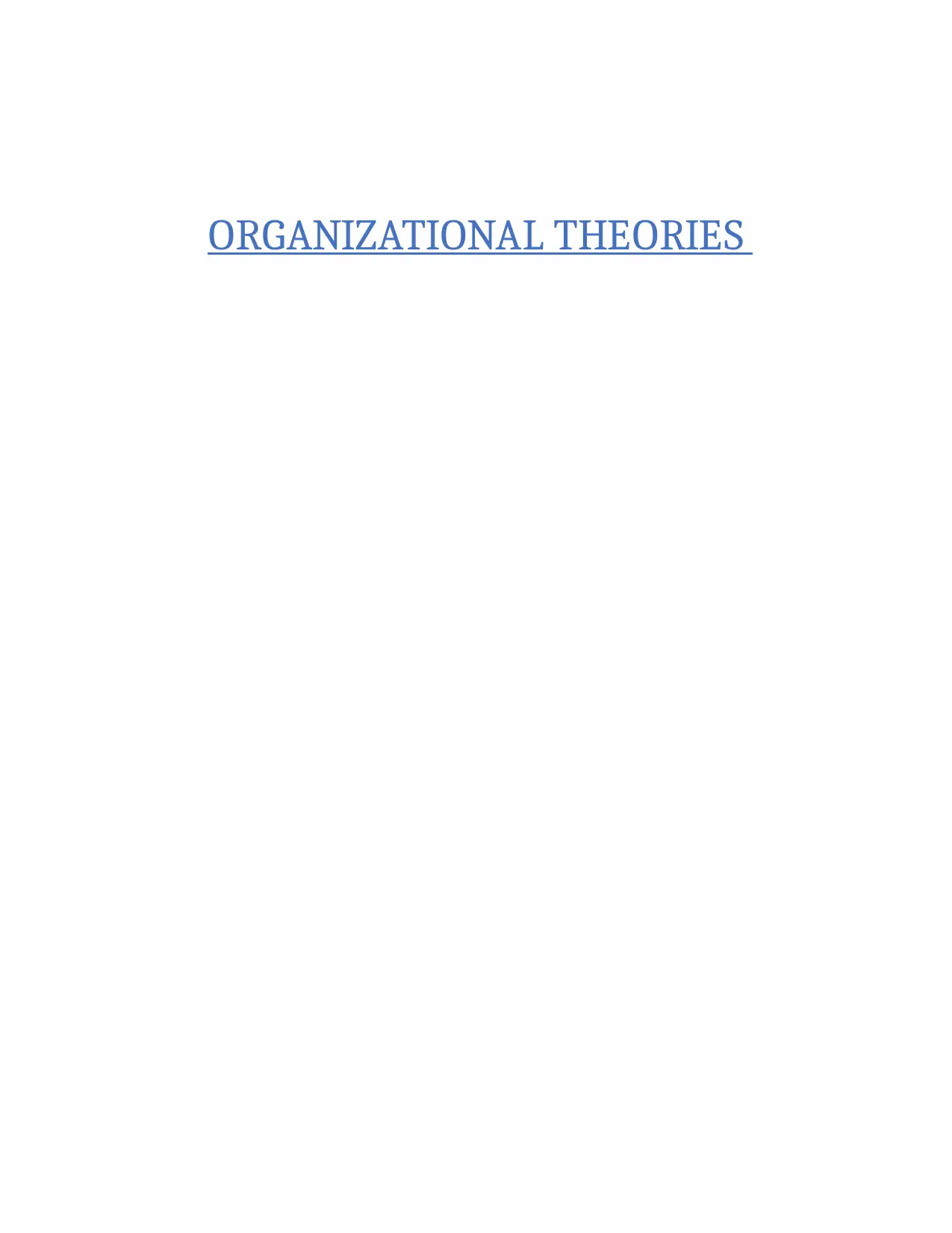
ORGANIZATIONAL THEORIES
Paraphrase This Document
Need a fresh take? Get an instant paraphrase of this document with our AI Paraphraser
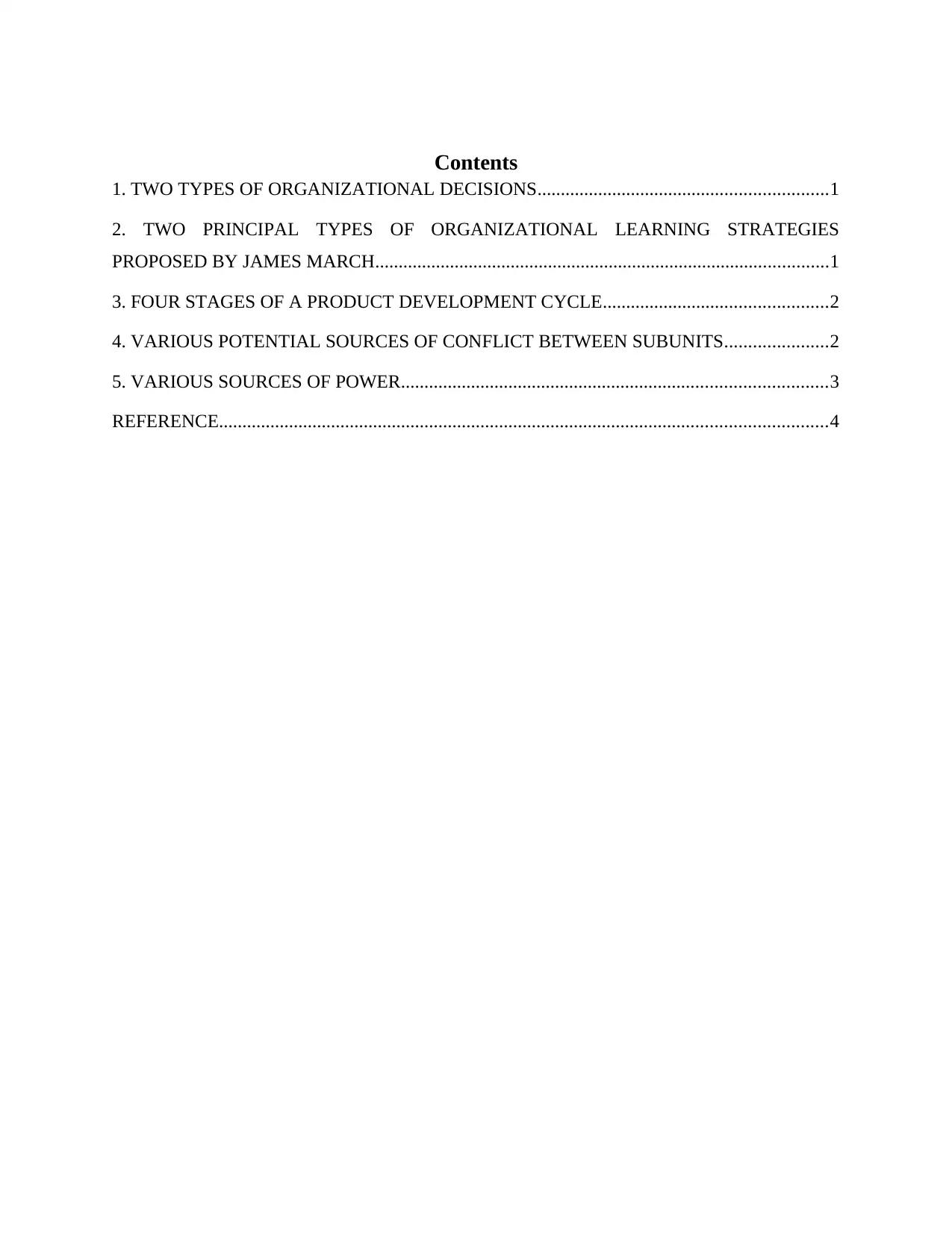
Contents
1. TWO TYPES OF ORGANIZATIONAL DECISIONS..............................................................1
2. TWO PRINCIPAL TYPES OF ORGANIZATIONAL LEARNING STRATEGIES
PROPOSED BY JAMES MARCH.................................................................................................1
3. FOUR STAGES OF A PRODUCT DEVELOPMENT CYCLE................................................2
4. VARIOUS POTENTIAL SOURCES OF CONFLICT BETWEEN SUBUNITS......................2
5. VARIOUS SOURCES OF POWER...........................................................................................3
REFERENCE..................................................................................................................................4
1. TWO TYPES OF ORGANIZATIONAL DECISIONS..............................................................1
2. TWO PRINCIPAL TYPES OF ORGANIZATIONAL LEARNING STRATEGIES
PROPOSED BY JAMES MARCH.................................................................................................1
3. FOUR STAGES OF A PRODUCT DEVELOPMENT CYCLE................................................2
4. VARIOUS POTENTIAL SOURCES OF CONFLICT BETWEEN SUBUNITS......................2
5. VARIOUS SOURCES OF POWER...........................................................................................3
REFERENCE..................................................................................................................................4
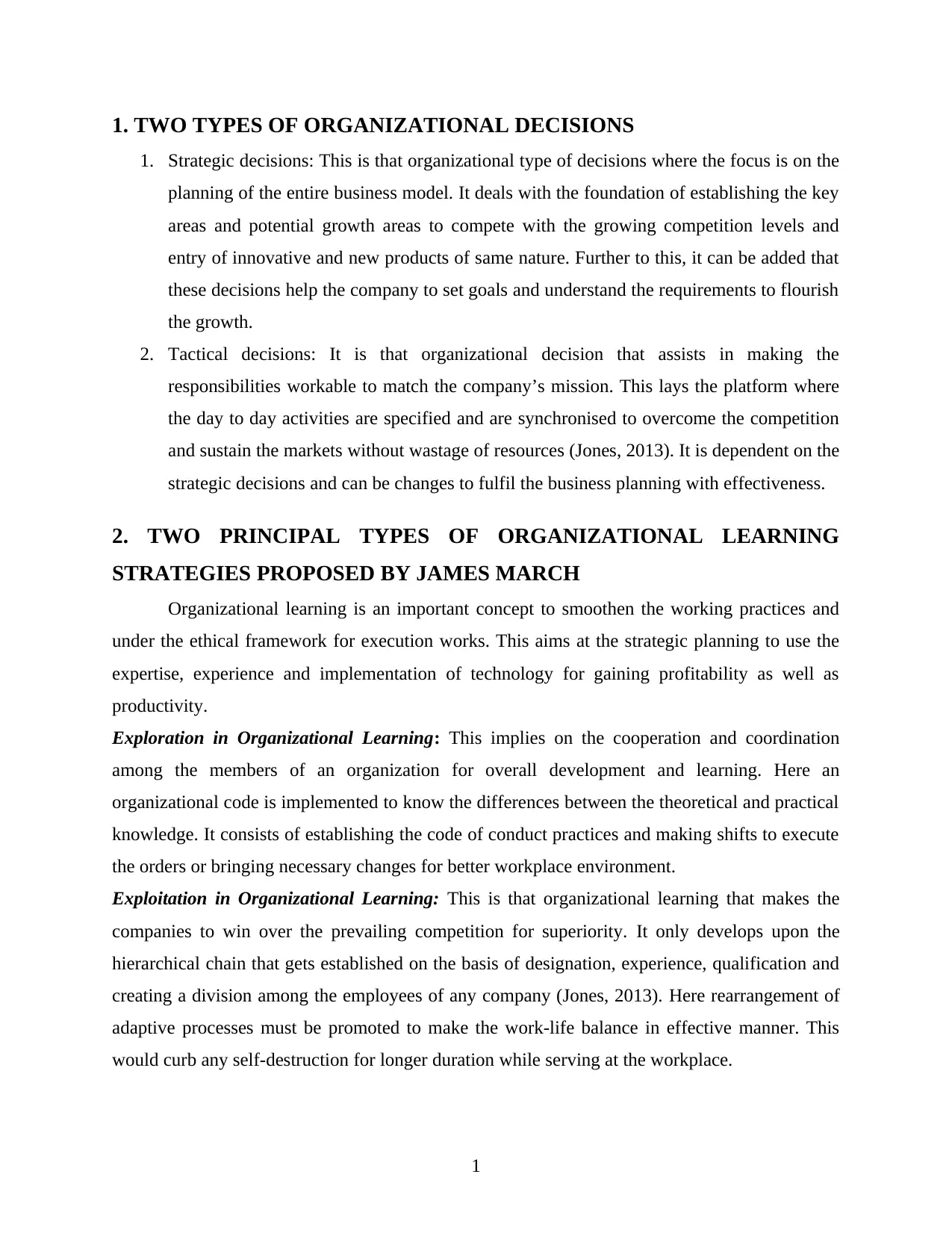
1. TWO TYPES OF ORGANIZATIONAL DECISIONS
1. Strategic decisions: This is that organizational type of decisions where the focus is on the
planning of the entire business model. It deals with the foundation of establishing the key
areas and potential growth areas to compete with the growing competition levels and
entry of innovative and new products of same nature. Further to this, it can be added that
these decisions help the company to set goals and understand the requirements to flourish
the growth.
2. Tactical decisions: It is that organizational decision that assists in making the
responsibilities workable to match the company’s mission. This lays the platform where
the day to day activities are specified and are synchronised to overcome the competition
and sustain the markets without wastage of resources (Jones, 2013). It is dependent on the
strategic decisions and can be changes to fulfil the business planning with effectiveness.
2. TWO PRINCIPAL TYPES OF ORGANIZATIONAL LEARNING
STRATEGIES PROPOSED BY JAMES MARCH
Organizational learning is an important concept to smoothen the working practices and
under the ethical framework for execution works. This aims at the strategic planning to use the
expertise, experience and implementation of technology for gaining profitability as well as
productivity.
Exploration in Organizational Learning: This implies on the cooperation and coordination
among the members of an organization for overall development and learning. Here an
organizational code is implemented to know the differences between the theoretical and practical
knowledge. It consists of establishing the code of conduct practices and making shifts to execute
the orders or bringing necessary changes for better workplace environment.
Exploitation in Organizational Learning: This is that organizational learning that makes the
companies to win over the prevailing competition for superiority. It only develops upon the
hierarchical chain that gets established on the basis of designation, experience, qualification and
creating a division among the employees of any company (Jones, 2013). Here rearrangement of
adaptive processes must be promoted to make the work-life balance in effective manner. This
would curb any self-destruction for longer duration while serving at the workplace.
1
1. Strategic decisions: This is that organizational type of decisions where the focus is on the
planning of the entire business model. It deals with the foundation of establishing the key
areas and potential growth areas to compete with the growing competition levels and
entry of innovative and new products of same nature. Further to this, it can be added that
these decisions help the company to set goals and understand the requirements to flourish
the growth.
2. Tactical decisions: It is that organizational decision that assists in making the
responsibilities workable to match the company’s mission. This lays the platform where
the day to day activities are specified and are synchronised to overcome the competition
and sustain the markets without wastage of resources (Jones, 2013). It is dependent on the
strategic decisions and can be changes to fulfil the business planning with effectiveness.
2. TWO PRINCIPAL TYPES OF ORGANIZATIONAL LEARNING
STRATEGIES PROPOSED BY JAMES MARCH
Organizational learning is an important concept to smoothen the working practices and
under the ethical framework for execution works. This aims at the strategic planning to use the
expertise, experience and implementation of technology for gaining profitability as well as
productivity.
Exploration in Organizational Learning: This implies on the cooperation and coordination
among the members of an organization for overall development and learning. Here an
organizational code is implemented to know the differences between the theoretical and practical
knowledge. It consists of establishing the code of conduct practices and making shifts to execute
the orders or bringing necessary changes for better workplace environment.
Exploitation in Organizational Learning: This is that organizational learning that makes the
companies to win over the prevailing competition for superiority. It only develops upon the
hierarchical chain that gets established on the basis of designation, experience, qualification and
creating a division among the employees of any company (Jones, 2013). Here rearrangement of
adaptive processes must be promoted to make the work-life balance in effective manner. This
would curb any self-destruction for longer duration while serving at the workplace.
1
⊘ This is a preview!⊘
Do you want full access?
Subscribe today to unlock all pages.

Trusted by 1+ million students worldwide
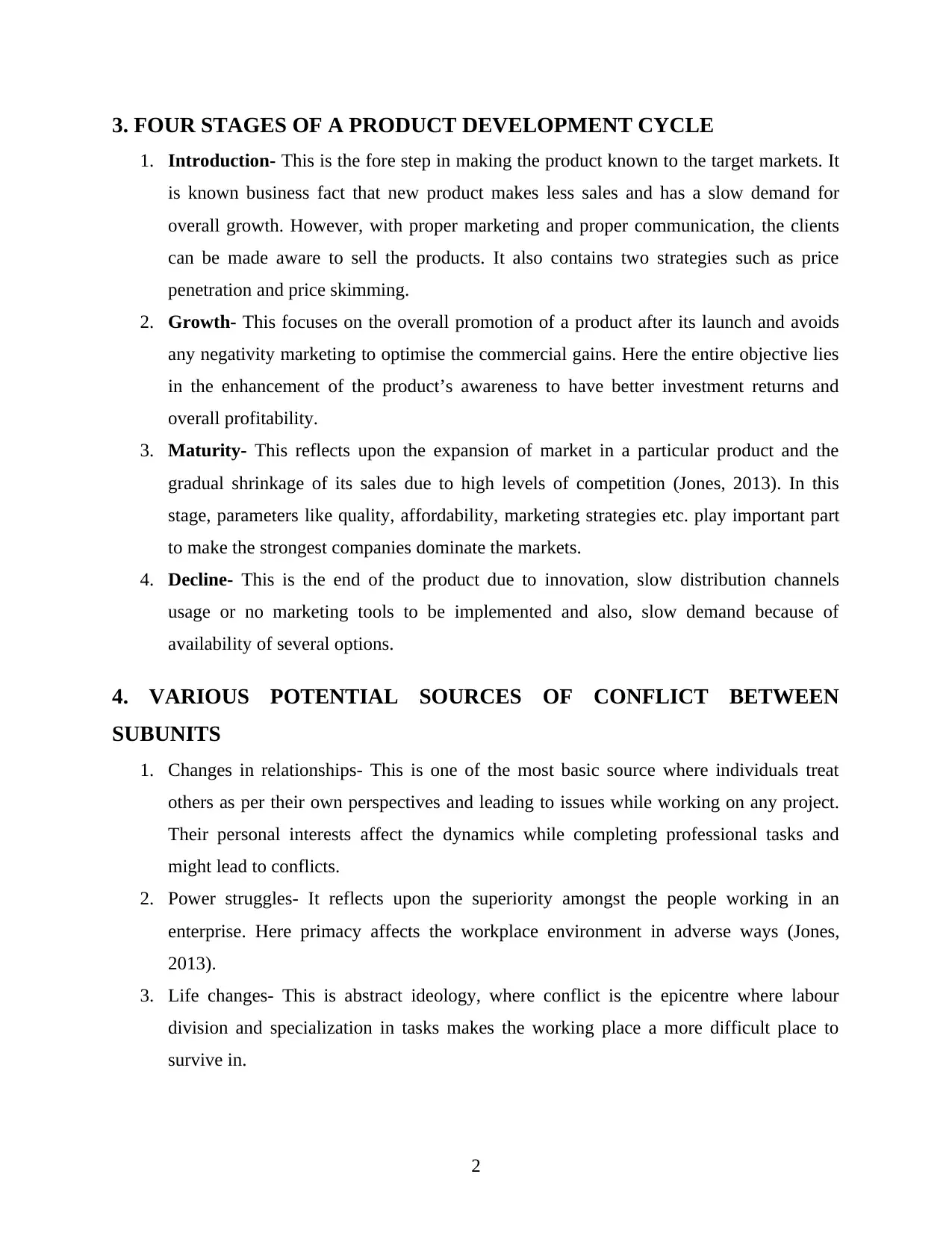
3. FOUR STAGES OF A PRODUCT DEVELOPMENT CYCLE
1. Introduction- This is the fore step in making the product known to the target markets. It
is known business fact that new product makes less sales and has a slow demand for
overall growth. However, with proper marketing and proper communication, the clients
can be made aware to sell the products. It also contains two strategies such as price
penetration and price skimming.
2. Growth- This focuses on the overall promotion of a product after its launch and avoids
any negativity marketing to optimise the commercial gains. Here the entire objective lies
in the enhancement of the product’s awareness to have better investment returns and
overall profitability.
3. Maturity- This reflects upon the expansion of market in a particular product and the
gradual shrinkage of its sales due to high levels of competition (Jones, 2013). In this
stage, parameters like quality, affordability, marketing strategies etc. play important part
to make the strongest companies dominate the markets.
4. Decline- This is the end of the product due to innovation, slow distribution channels
usage or no marketing tools to be implemented and also, slow demand because of
availability of several options.
4. VARIOUS POTENTIAL SOURCES OF CONFLICT BETWEEN
SUBUNITS
1. Changes in relationships- This is one of the most basic source where individuals treat
others as per their own perspectives and leading to issues while working on any project.
Their personal interests affect the dynamics while completing professional tasks and
might lead to conflicts.
2. Power struggles- It reflects upon the superiority amongst the people working in an
enterprise. Here primacy affects the workplace environment in adverse ways (Jones,
2013).
3. Life changes- This is abstract ideology, where conflict is the epicentre where labour
division and specialization in tasks makes the working place a more difficult place to
survive in.
2
1. Introduction- This is the fore step in making the product known to the target markets. It
is known business fact that new product makes less sales and has a slow demand for
overall growth. However, with proper marketing and proper communication, the clients
can be made aware to sell the products. It also contains two strategies such as price
penetration and price skimming.
2. Growth- This focuses on the overall promotion of a product after its launch and avoids
any negativity marketing to optimise the commercial gains. Here the entire objective lies
in the enhancement of the product’s awareness to have better investment returns and
overall profitability.
3. Maturity- This reflects upon the expansion of market in a particular product and the
gradual shrinkage of its sales due to high levels of competition (Jones, 2013). In this
stage, parameters like quality, affordability, marketing strategies etc. play important part
to make the strongest companies dominate the markets.
4. Decline- This is the end of the product due to innovation, slow distribution channels
usage or no marketing tools to be implemented and also, slow demand because of
availability of several options.
4. VARIOUS POTENTIAL SOURCES OF CONFLICT BETWEEN
SUBUNITS
1. Changes in relationships- This is one of the most basic source where individuals treat
others as per their own perspectives and leading to issues while working on any project.
Their personal interests affect the dynamics while completing professional tasks and
might lead to conflicts.
2. Power struggles- It reflects upon the superiority amongst the people working in an
enterprise. Here primacy affects the workplace environment in adverse ways (Jones,
2013).
3. Life changes- This is abstract ideology, where conflict is the epicentre where labour
division and specialization in tasks makes the working place a more difficult place to
survive in.
2
Paraphrase This Document
Need a fresh take? Get an instant paraphrase of this document with our AI Paraphraser
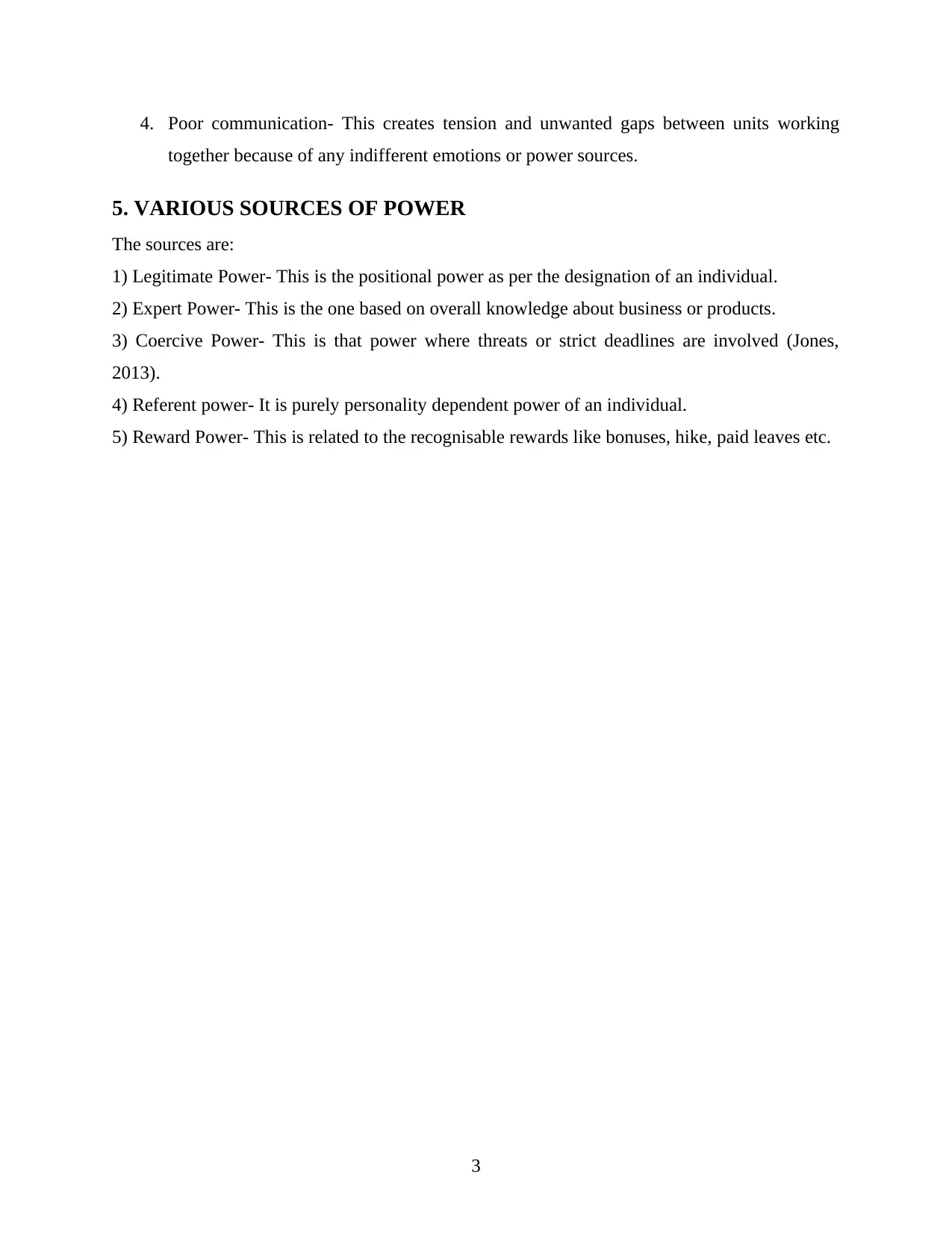
4. Poor communication- This creates tension and unwanted gaps between units working
together because of any indifferent emotions or power sources.
5. VARIOUS SOURCES OF POWER
The sources are:
1) Legitimate Power- This is the positional power as per the designation of an individual.
2) Expert Power- This is the one based on overall knowledge about business or products.
3) Coercive Power- This is that power where threats or strict deadlines are involved (Jones,
2013).
4) Referent power- It is purely personality dependent power of an individual.
5) Reward Power- This is related to the recognisable rewards like bonuses, hike, paid leaves etc.
3
together because of any indifferent emotions or power sources.
5. VARIOUS SOURCES OF POWER
The sources are:
1) Legitimate Power- This is the positional power as per the designation of an individual.
2) Expert Power- This is the one based on overall knowledge about business or products.
3) Coercive Power- This is that power where threats or strict deadlines are involved (Jones,
2013).
4) Referent power- It is purely personality dependent power of an individual.
5) Reward Power- This is related to the recognisable rewards like bonuses, hike, paid leaves etc.
3
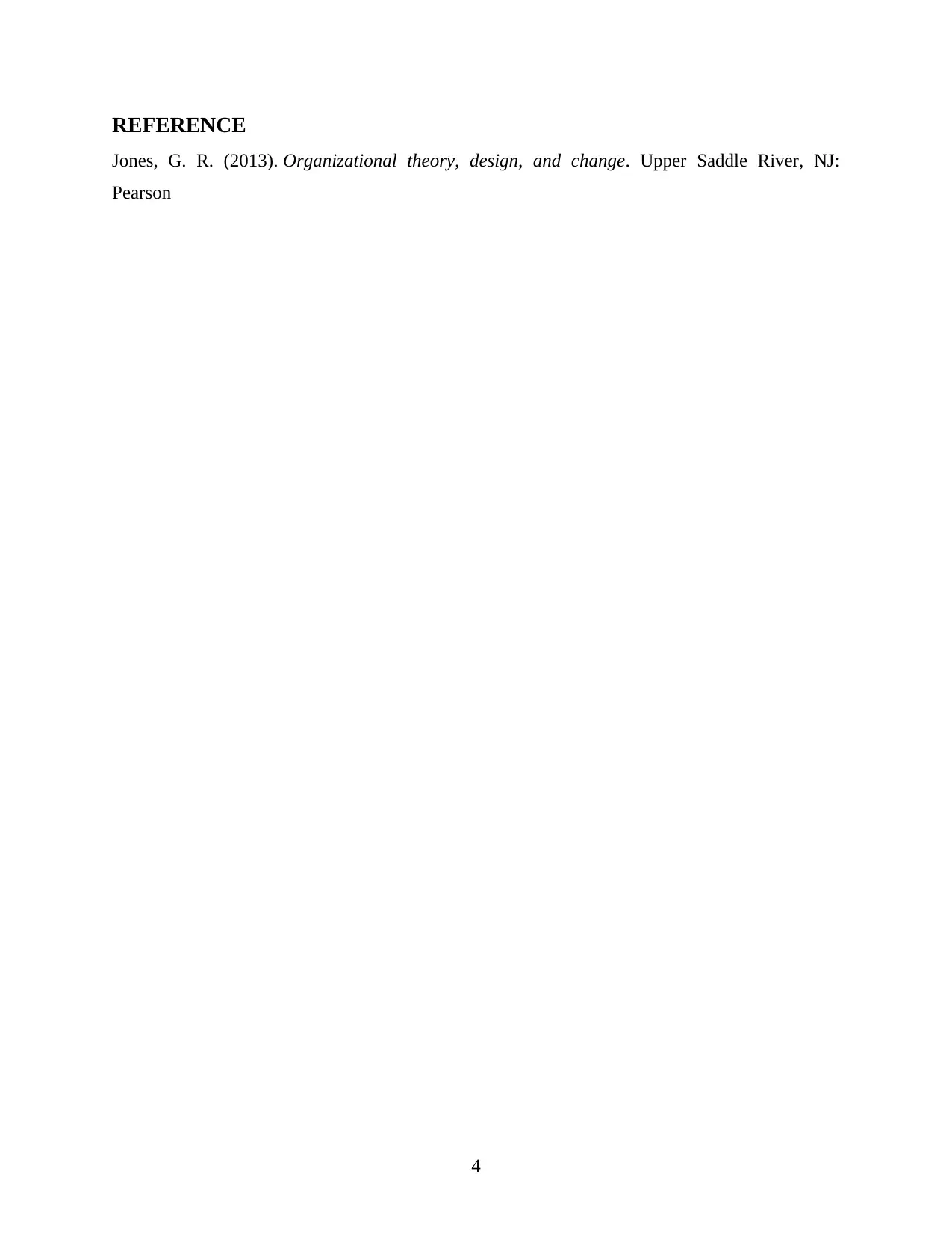
REFERENCE
Jones, G. R. (2013). Organizational theory, design, and change. Upper Saddle River, NJ:
Pearson
4
Jones, G. R. (2013). Organizational theory, design, and change. Upper Saddle River, NJ:
Pearson
4
⊘ This is a preview!⊘
Do you want full access?
Subscribe today to unlock all pages.

Trusted by 1+ million students worldwide
1 out of 6
Related Documents
Your All-in-One AI-Powered Toolkit for Academic Success.
+13062052269
info@desklib.com
Available 24*7 on WhatsApp / Email
![[object Object]](/_next/static/media/star-bottom.7253800d.svg)
Unlock your academic potential
Copyright © 2020–2025 A2Z Services. All Rights Reserved. Developed and managed by ZUCOL.





